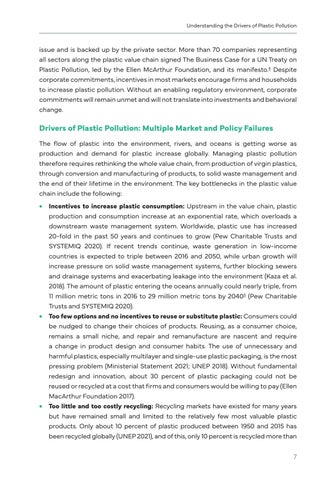Understanding the Drivers of Plastic Pollution
issue and is backed up by the private sector. More than 70 companies representing all sectors along the plastic value chain signed The Business Case for a UN Treaty on Plastic Pollution, led by the Ellen McArthur Foundation, and its manifesto.4 Despite corporate commitments, incentives in most markets encourage firms and households to increase plastic pollution. Without an enabling regulatory environment, corporate commitments will remain unmet and will not translate into investments and behavioral change.
Drivers of Plastic Pollution: Multiple Market and Policy Failures The flow of plastic into the environment, rivers, and oceans is getting worse as production and demand for plastic increase globally. Managing plastic pollution therefore requires rethinking the whole value chain, from production of virgin plastics, through conversion and manufacturing of products, to solid waste management and the end of their lifetime in the environment. The key bottlenecks in the plastic value chain include the following: ••Incentives to increase plastic consumption: Upstream in the value chain, plastic production and consumption increase at an exponential rate, which overloads a downstream waste management system. Worldwide, plastic use has increased 20-fold in the past 50 years and continues to grow (Pew Charitable Trusts and SYSTEMIQ 2020). If recent trends continue, waste generation in low-income countries is expected to triple between 2016 and 2050, while urban growth will increase pressure on solid waste management systems, further blocking sewers and drainage systems and exacerbating leakage into the environment (Kaza et al. 2018). The amount of plastic entering the oceans annually could nearly triple, from 11 million metric tons in 2016 to 29 million metric tons by 20405 (Pew Charitable Trusts and SYSTEMIQ 2020). ••Too few options and no incentives to reuse or substitute plastic: Consumers could be nudged to change their choices of products. Reusing, as a consumer choice, remains a small niche, and repair and remanufacture are nascent and require a change in product design and consumer habits. The use of unnecessary and harmful plastics, especially multilayer and single-use plastic packaging, is the most pressing problem (Ministerial Statement 2021; UNEP 2018). Without fundamental redesign and innovation, about 30 percent of plastic packaging could not be reused or recycled at a cost that firms and consumers would be willing to pay (Ellen MacArthur Foundation 2017). ••Too little and too costly recycling: Recycling markets have existed for many years but have remained small and limited to the relatively few most valuable plastic products. Only about 10 percent of plastic produced between 1950 and 2015 has been recycled globally (UNEP 2021), and of this, only 10 percent is recycled more than 7





